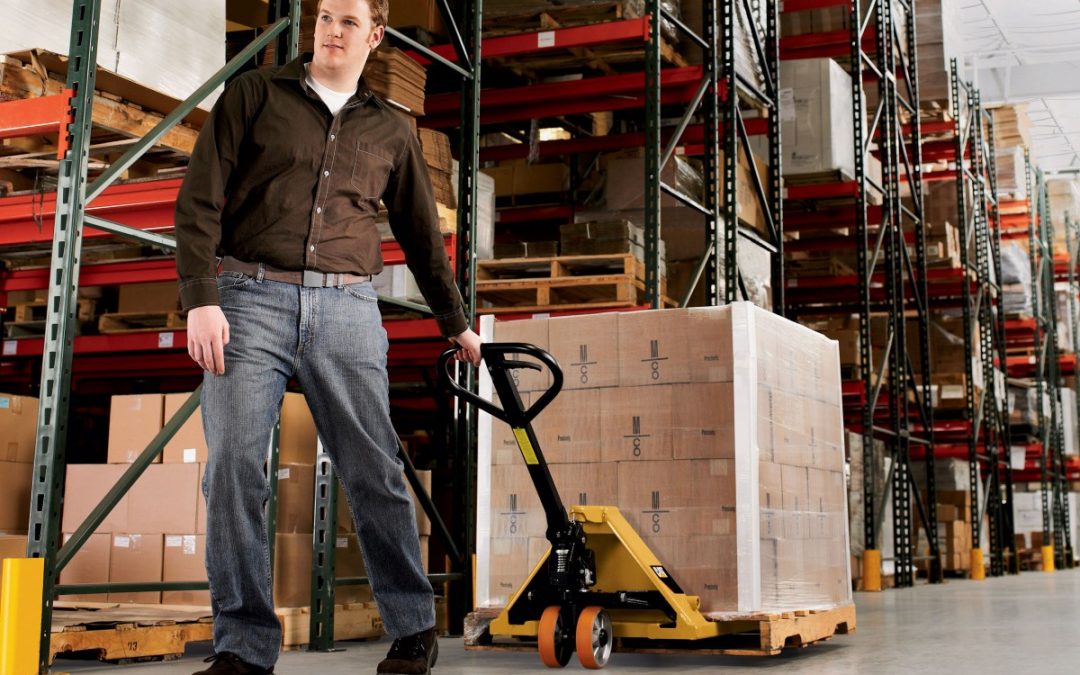Modern warehouses range from the simple conventional setup, where people stack shelves by hand during the working day, to lights-out facilities that are automated to the point where they can keep functioning even when the lights are off. But regardless of the level of automation in place or the specific materials that the warehouse processes, material handling equipment is integral to any warehouse’s functioning today.
What is material handling equipment?
Material handling equipment is exactly what it sounds like; the equipment used to load, unload, and move goods within factories and warehouses. Without material handling equipment, warehouses would have to move everything by hand. Needless to say, this would be a much less efficient way of doing things.
Material handling equipment falls into four main categories.
Storage and handling equipment
This category consists of the simple types of material handling equipment. In fact, much of the equipment in this category is so basic that you probably wouldn’t even think of it as being equipment. For example, shelves and racks that can support material while it’s being transported and received fall into this category. The design of shelves and racks will determine how efficiently warehouses can use their vertical space.
Other common material handling equipment in this category includes bins, stacking frames, drawers, mezzanines and flow and cantilever racks.
Bulk material handling equipment
Equipment in this category is used in the storage and transportation of loose materials in bulk form. Wherever you have a lot of material bundled together and being transported as individual units, you will find bulk material handling equipment. For example, large machines like tackers and reclaimers that either pick up piles of stuff or dump material into piles fall into this category.
Other bulk handling equipment is more precise. Hoppers ook like little more than large metal funnels. However, they can store material and release precise quantities as required.
Specialised elevator systems, such as grain elevators and bucket elevators, are also considered part of this equipment category. These systems are used to transport material between different elevations. Similarly, conveyor belts that transport material horizontally also come under this category.
Industrial trucks
Before a warehouse can process material, it first needs to be transported from the source. Industrial trucks are the vehicles used to move material from place to place. In the last few years, we have seen the introduction of automated guided vehicles, which can drive themselves. Some people consider these to be engineered systems, rather than part of the industrial trucks category.
Not all the equipment in this category consists of vehicles, however. Hand trucks, more commonly known as dollies, are also part of this category. Similarly, side-loaders, which enable warehouse workers to load materials in spaces too narrow for other equipment, also come under the industrial trucks category.
This category also contains most of the vehicles commonly found within warehouses, such as pallet trucks. These can be electric or hand-operated devices used to move pallets around the warehouse. Similar vehicles include walkie stackers, which more closely resemble forklifts, and forklifts themselves.
Finally, there is the equipment used to move workers. For example, order pickers lift workers so they can access material that is stored high up.
Engineered systems
Engineered systems are the most complex examples of material handling equipment. This equipment consists of complicated systems, often comprised of multiple components. Much of the equipment in this category is automated, like the aforementioned AGVs. Like AGVs, lots of the equipment in this category also fit in one of the other categories. For example, conveyor belts are often regarded as engineered systems, but they are also part of the bulk material handling equipment category.
Automated Storage and Retrieval Systems can move material around in modern warehouses without the need for workers to do anything. These systems combine AGVs with software and other components to improve warehouse efficiency.
Why equipment matters
Having the right material handling equipment in your business is essential for several reasons:
- Save time: Having the right material handling equipment on-site ensures you can always move material when you need to. If you don’t have the right equipment in place, it can create a backlog while you figure out what you’re going to do. Using the optimal equipment to handle and move material enables you to work as quickly as possible without compromising safety.
- Improve efficiency: Efficiency is essential for any business. The right material handling equipment will ensure material flows through your warehouse as efficiently as possible.
- Safety: Warehouse operators can’t afford to drop the ball when it comes to their workers’ safety. Having the right equipment in place is essential for maintaining a safe working environment.
SHS Handling stocks a range of materials and handling equipment. We have all the essentials for construction and warehousing businesses, and we only stock the best. We guarantee excellence in every piece of equipment we sell. Contact us today to find out if we have the equipment you need for your warehouse.

